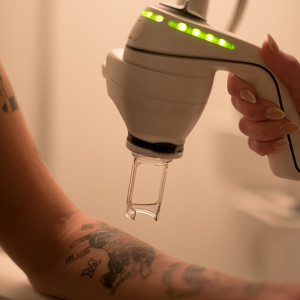Research supports the efficacy of the LightSense™ laser and gives an insight into how laser tattoo removal works
If you are choosing laser tattoo removal at NAAMA Studios in London the chances are you’ve already done a fair bit of research. From reading our candid client stories - (“I wondered how the skin can regenerate after two weeks. There's no way, I thought. But it manages to do it!” - Lydia) - to browsing through our celebrity Instagram endorsements, you’ll find plenty of content on how and why the LightSense™ laser absolutely smashes it. (An apposite phrase here, you’ll soon discover). But what about the science behind how laser tattoo removal actually works, and why it is providing such fantastic results? Don’t just take laser advice from us, read this blog from the scientific experts studying how laser tattoo removal works and learn why the extremely short pulse width of the LightSense™ laser is beneficial for the health and safety of your most important organ: the skin. Forget doom scrolling Reddit forums on tattoo removal before and afters, here’s a deep dive into the scientific research on how laser tattoo removal actually works.
Publish Date in article
THE LIGHTSENSE™ LASER HAS AN IMPRESSIVELY SHORT PULSE WIDTH OF JUST EIGHT PICOSECONDS.
"A shorter laser pulse results in more efficient breakdown of tattoo particles" - from the article in Nature
Published in Nature
Nature is one of the world’s most authoritative scientific publications, regularly topping the leaderboards of high-impact journals. In the world of scientific publishing, impact factor is an index that attempts to reflect how many times the articles in the publication are cited. Essentially, it’s how boss the journal is.
Publish Date in article
The findings
The authors of the article discovered how laser tattoo removal works: “Computational simulation study of laser-tissue interactions found photoacoustic effects to be the most salient mechanism of laser-assisted tattoo removal and that a shorter laser pulse results in more efficient breakdown of tattoo particles.” OK, now that paragraph needs a lot of unpicking. First thing to say, they didn’t do the study on actual human skin. They used fake skin, or phantoms. “Although [tissue-mimicking] phantoms are not identical to in vivo human skin, due to the lack of cellular components, adnexal structures, and a layered composition, [photoacoustic injury zones] in TM phantom have been deemed to accurately reflect macroscopic laser-tattoo interactions and surrounding tissue reactions immediately after laser treatment for tattoo removal.” For your reference, the phantoms look a bit like this. Now for the meat of the article. A photoacoustic effect is when the pulse of the LightSense™ laser generates ultrasound waves in the dermis of the skin. Not only does the heat of the laser agitate the tattoo ink, smashing it apart into smaller particles, it also causes this secondary effect. According to the article in Nature, this is crucial for the successful clearance of tattoos: it is the “salient mechanism of laser-assisted tattoo removal.” Following on from this, the experts claim that, “a shorter laser pulse results in more efficient breakdown of tattoo particles.” The pulse width is how long the pulse or flash of light is on for. The LightSense™ laser has an impressively short pulse width of just eight picoseconds. So you can see why NAAMA Studios only uses the LightSense™ laser to safely and effectively treat tattoos. You can read the entire study here for more information on how laser tattoo removal works, or speak to one of our expert consultants about why we only use the LightSense™ laser. It has over 30,000 successful treatments and plenty of satisfied clients.









